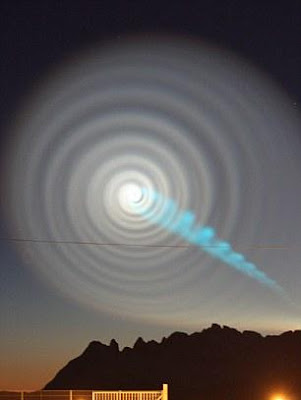New evidence emerged today that a mysterious spiral light display which appeared in the dark skies over Norway yesterday morning was caused by an embarrassing failed test launch of a jinxed Russian missile.
The Bulava missile was test-fired from the Dmitry Donskoi submarine in the White Sea early on Wednesday but failed at the third stage, the Russian military confirmed today.
New video also emerged today showing a simulation of what would happen if such a missile were to fail - video that bore an uncanny resemblance to the light display seen in the Norwegian sky.



 The military did not confirm, however, that the failed test launch was behind the mysterious spiral lights that have baffled millions since they were spotted - though, as the new video today showed, it appears increasingly likely.
The military did not confirm, however, that the failed test launch was behind the mysterious spiral lights that have baffled millions since they were spotted - though, as the new video today showed, it appears increasingly likely.
The mystery began when a blue light seemed to soar up from behind a mountain in the north of the country. It stopped mid-air, then began to move in circles. Within seconds a giant spiral had covered the entire sky.
See video showing part of the light display, and a simulation showing how the display may have been created below
Then a green-blue beam of light shot out from its centre - lasting for ten to 12 minutes before disappearing completely.
Onlookers describing it as 'like a big fireball that went around, with a great light around it' and 'a shooting star that spun around and around'.
Yesterday a Norwegian defence spokesman said the display was most likely from a failed Russian test launch.
 Tromsō Geophysical Observatory researcher Truls Lynne Hansen agreed, saying the missile had likely veered out of control and exploded, and the spiral was light reflecting on the leaking fuel.
Tromsō Geophysical Observatory researcher Truls Lynne Hansen agreed, saying the missile had likely veered out of control and exploded, and the spiral was light reflecting on the leaking fuel.
Last night Russia initially denied it had been conducting missile tests in the area.
However this morning the military reversed its stance, admitting that a missile had indeed been launched from the White Sea। Test firings are usually made from the White Sea, close to the Norwegian Arctic region.
Kommersant newspaper reported today that a test-firing before dawn on Wednesday coincided with the light show in the northern sky.
It also emerged today that Russia last week formally notified Norway of a window when a missile test might be carried out.


 This included a seven hour period early on Wednesday at the time when the lights were seen.
This included a seven hour period early on Wednesday at the time when the lights were seen.
The submarine Dmitry Donskoy went to sea on Monday, ahead of the test, and some reports suggest the vessel is now back in port.
A Russian military source said today that 'the third stage of the rocket did not work'.
The Bulava, despite being crucial to Russia's plans to revamp its weaponry, is becoming an embarrassment after nine failed launches in 13 tests, prompting calls for it to be scrapped.
In theory, it has a range of 5,000 miles and could carry up to ten nuclear weapons bound for separate targets.
A previous failure in July forced the resignation of Yury Solomonov, the director of the Moscow Institute of Thermal Technology which is responsible for developing the missile.
However, he is now working as chief designer on the jinxed project.
The Norwegian Meteorological Institute was flooded with telephone calls after the light storm yesterday morning.
Totto Eriksen, from Tromsø, told VG Nett: 'It spun and exploded in the sky,'
He spotted the lights as he walked his daughter Amalie to school.
He said: 'We saw it from the Inner Harbor in Tromsø. It was absolutely fantastic.
'It almost looked like a rocket that spun around and around and then went diagonally down the heavens.
'It looked like the moon was coming over the mountain, but then came something completely different.'
The lights appeared to be unconnected with the aurora borealis, or northern lights, the natural magnetic phenomena that can often be viewed in that part of the world.
Celebrity astronomer Knut Jørgen Røed Ødegaard said he had never seen anything like the lights.
He said: 'My first thought was that it was a fireball meteor, but it has lasted far too long.
'It may have been a missile in Russia, but I can not guarantee that it is the answer.'
Air traffic control in Tromsō claimed the light show lasted 'far too long to be an astronomical phenomenon'.
See video showing part of the light here, and a simulation showing how the display may have been created below
Thursday, December 10, 2009
Amazing Norway's spiral light display 'was down to a failed Russian Bulava missile test'
Tags:




0 comments:
Post a Comment